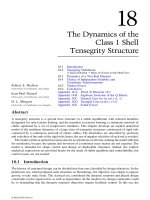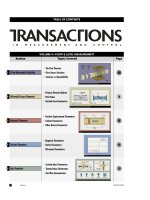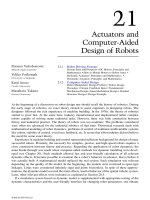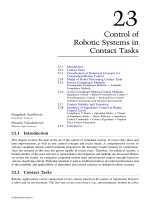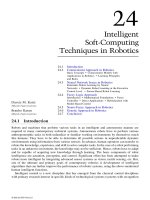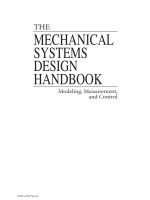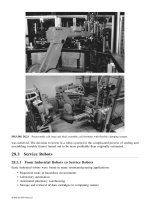Modeling, Measurement and Control P21
Bạn đang xem bản rút gọn của tài liệu. Xem và tải ngay bản đầy đủ của tài liệu tại đây (2.45 MB, 34 trang )
21
Actuators and
Computer-Aided
Design of Robots
21.1 Robot Driving Systems
Present State and Prospects • DC Motors: Principles and
Mathematics • How to Mount Motors to Robot Arms •
Hydraulic Actuators: Principles and Mathematics •
Pneumatic Actuators: Principles and Mathematics
21.2 Computer-Aided Design
Robot Manipulator Design Problem • Robot Design
Procedure • Design Condition Input • Fundamental
Mechanism Design • Inner Mechanism Design • Detailed
Structure Design • Design Example
At the beginning of a discussion on robot design one should recall the history of robotics. During
the early stage of robotics, no exact theory existed to assist engineers in designing robots. The
designers followed the rich experience of machine building. In the 1970s, the theory of robotics
started to grow fast. At the same time, industry manufactured and implemented rather complex
robots capable of solving many industrial tasks. However, there was little connection between
theory and industrial practice. The theory of robots was too academic. The problems considered
were often too advanced for the industrial robotics of that time. Theoretical research dealt with
mathematical modeling of robot dynamics, problems of control of nonlinear multivariable systems
like robots, stability of control, even force feedback, etc. It seems that robot industry did not believe
the need for some exact theory.
Experience in machine building and control represented sufficient background for design of many
successful robots. Presently, the necessity for complex, precise, and high-speed robots requires a
close connection between theory and practice. Regarding the application of robot dynamics, the
main break-through was made when computer-aided methods for dynamic modeling were devel-
oped (see Chapter 20). Such methods allowed fast and user-friendly calculation of all relevant
dynamic effects. It became possible to examine the a robot’s behavior in advance, that is before it
was actually built. A mathematical model replaced the real system. Such simulation was relevant
depending on the quality of the model. In the beginning, the models were restricted to open-type
linkages. Links were considered infinitely rigid and joints frictionless. In spite of these approxi-
mations, the dynamic model covered the main effects, inertial behavior of the spatial robotic system.
Later, other relevant effects were included as explained in Section 20.5.
If a simulation system based on dynamic model is supplemented with appropriate testing of the
dynamic characteristics and the user-friendly interface for changing robot parameters, one obtains
Miomir Vukobratovi
´
c
Mihajlo Pupin Institute
Veljko Potkonjak
University of Belgrade
Kenji Inoue
Osaka University
Masaharu Takano
Kansai University
8596Ch21Frame Page 523 Tuesday, November 6, 2001 9:51 PM
© 2002 by CRC Press LLC
a very useful design tool. A designer can examine the influence of certain parameters to robot
performance and then change the parameters to improve the results. In this way, step by step, he
or she approaches the optimal design. Finally, it is possible to create a software system that includes
optimization procedures, thus automating the choice of robot parameters. This is a brief idea of
something called computer-aided design (CAD).
1,16
When selecting the topics for this chapter devoted to robot design we started from the fact that
technology grows fast. Thus, some currently advanced constructive solutions might soon become
obsolete. Hence, we decided to avoid presentation of specific constructive solutions and try to
explain advanced principles of robot design. First, it was necessary to discuss robot-driving systems.
It is important because the choice of actuator type (electric, hydraulic, or pneumatic) is one of the
first decisions in the design process and many constructive solutions depend on this choice. Also,
dynamic models of actuators are needed for knowledge of overall robot dynamics and to create
the simulation system. Actuators and their impact to robot design are discussed in Section 21.1;
Section 21.2 gives the principles of advanced design. A CAD system for industrial robots is
described.
21.1 Robot Driving Systems
Discussion on robot-driving systems is important for several reasons. First, we address the problem
of dynamic modeling. The actuators represent a subsystem of the entire robot. It is often said that
a robot consists of a mechanical part (robot mechanism) and actuators. For mathematical modeling
of robot dynamics it is necessary to take care of all dynamic effects, those introduced by the
mechanism (e.g., link inertia) and those due to actuators (e.g., rotor inertia, counter electromotive
forces, etc.).
1,2
Such a model of the complete dynamics is derived in Sections 21.3.1 and 21.3.2.
The problem of control is strongly influenced by the choice of actuators. For instance, DC motors,
stepper motors, and hydraulic actuators require different hardware and software solutions. The
problem of control is closely related to the driving characteristics of different types of actuators.
Finally, constructive solutions of the robot’s mechanical part depend on the choice of actuators.
For instance, if a hydraulic cylinder drives a robot elbow, it is attached to the upperarm and the
forearm, representing a kind of direct drive. On the other hand, if a DC motor is used, it is usually
displaced from the elbow and located on the robot base. This concept understands a mechanism
for transmitting motor power to the joint.
So, when elaborating robot actuators it is necessary to stress the following points: operation
principles, mathematical modeling, driving characteristics, and mounting on the robot arm. Section
21.1.1 presents a review of actuators currently used in robots and automation. The main charac-
teristics, advantages, and drawbacks are mentioned without detailed explanation. The idea is to
stress those points that are important for implementation. In the paragraphs that follow we discuss
the principles of operation and the mathematical description of most common types of actuators.
Some constructive aspects of actuator implementation are also considered (especially the transmis-
sion). Presentation covers DC motors, hydraulic actuators, and pneumatic drive.
21.1.1 Present State and Prospects
In the early stage of robotics, pneumatic cylinders were often used to drive the manipulation
mechanisms. Such devices had limited motion possibilities. This follows from the binary character
of pneumatic actuators. The piston can extend to the final position or retract to the initial state and
no control is achieved between these two positions. This is due to the compressibility of the air
that flows through the cylinder. Thus, the manipulator can reach a set of points in space and
programming of motion means only the definition of the sequence of working points. Although
some special designs of pneumatic drives offer the possibility of achieving closed-loop control,
such actuators are not widely used in advanced robotic systems. However, there is still a need for
8596Ch21Frame Page 524 Tuesday, November 6, 2001 9:51 PM
© 2002 by CRC Press LLC
pick-and-place industrial systems positioned by mechanical stops. For such devices pneumatic
actuation represents a fast, cheap, and reliable solution.
The hydraulic actuator is to some extent similar to the pneumatic one but avoids its main
drawbacks. The uncompressible hydraulic oil flows through a cylinder and applies pressure to the
piston. This pressure force causes motion of the robot joint. Control of motion is achieved by
regulating the oil flow. The device used to regulate the flow is called a servovalve. Hydraulic systems
can produce linear or rotary actuation. There are many advantages of the hydraulic drives. Its main
benefit is the possibility of producing a very large force (or torque) without using geartrains. At
the same time, the effector attached to the robot arm allows high concentration of power within
small dimensions and weight. This is due to the fact that some massive parts of the actuator, like
the pump and the oil reservoir, are placed beside the robot and do not load the arm. With hydraulic
drives it is possible to achieve continuous motion control. The drawbacks one should mention are:
Hydraulic power supply is inefficient in terms of energy consumption
Leakage problem is present.
A fast-response servovalve is expensive.
If the complete hydraulic system is considered (reservoir, pump, cylinder and valve), the power
supply becomes bulky.
Electric motors (electromagnetic actuators) are the most common type of actuators in robots
today. They are used even for heavy robots for which some years ago hydraulics was exclusive.
This can be justified by the general conclusion that electric drives are easy to control by means of
a computer. This is especially the case with DC motors. However, it is necessary to mention some
drawbacks of electromagnetic actuation. Today, motors still rotate at rather high speed. Rated speed
is typically 3000 to 5000 r.p.m. At the same time, the output motor torque is small compared with
the value needed to move a robot joint. For instance, rated torque for a 250W DC motor with rare-
earth magnets may be 0.9 Nm. Hence, electric motors are in most cases followed by a reducer
(gear-box), a transmission element that reduces speed and increases torque. It is not uncommon
for a large reduction ratio to be needed (up to 300). The always present friction in gear-boxes
produces loss of energy. The efficiency (output to input power ratio) of a typical reducer, the
Harmonic Drive, is about 0.75. The next problem is backlash that has a negative influence on robot
position accuracy. Similar problems may arise from the unsatisfactory stiffness of the transmission.
An important question concerns the allocation of the motor on the robot arm. To unload the arm
and achieve better static balance, motors are usually displaced from the joints they drive. Motors
are moved toward the robot base. In such cases, additional transmission is needed between the
motor and the corresponding joint. Different types of shafts, chains, belts, ball screws, and linkage
structures may be used. The questions of efficiency, backlash, and stiffness are posed again. Finally,
the presence of transmission elements makes the entire structure more complex and expensive.
This main disadvantage of electric motors can be eliminated if direct drive is applied. This under-
stands motors powerful enough to operate without gearboxes or other types of transmission. Such
motors are located directly in the robot joints. Direct drive motors are used in advanced robots,
but not very often. Problems arise if high torques are needed. However, direct drive is a relatively
new and very promising concept.
5
The most widely used electromagnetic drive is the permanent magnet DC motor. Classical motor
structure has a rotor with wire windings and a stator with permanent magnets and includes brush-
commutation. There are several forms of rotors. A cylindrical rotor with iron has high inertia and
slow dynamic response. An ironless rotor consists of a copper conductor enclosed in a epoxy glass
cup or disk. A cup-shaped rotor retains the cylindrical-shaped motor while the disc-shaped rotor
allows short overall motor length. This might be of importance when designing a robot arm. A
disadvantage of ironless armature motors is that rotors have low thermal capacity. As a result,
motors have rigid duty cycle limitations or require forced-air cooling when driven at high torque
8596Ch21Frame Page 525 Tuesday, November 6, 2001 9:51 PM
© 2002 by CRC Press LLC
levels. Permanent magnets strongly influence the overall efficiency of motors. Low-cost motors
use ceramic (ferrite) magnets. Advanced motors use rare-earth (samarium-cobalt and neodymium-
boron) magnets. They can produce higher peak torques because they can accept large currents
without demagnetization. Such motors are generally smaller in size (better power to weight ratio).
However, large currents cause increased brush wear and rapid motor heating.
The main drawback of the classical structure comes from commutation. Graphite brushes and a
copper bar commutator introduce friction, sparking, and the wear of commutating parts. Sparking
is one of the factors that limits motor driving capability. It limits the current at high rotation speed
and thus high torques are only possible at low speed. These disadvantages can be avoided if wire
windings are placed on the stator and permanent magnets on the rotor. Electronic commutation
replaces the brushes and copper bar commutator and supplies the commutated voltage (rectangular
or trapezoidal shape of signal). Such motors are called brushless DC motors. Sometimes, the term
synchronous AC motor is used although a difference exists (as will be explained later). In addition
to avoiding commutation problems, increased reliability and improved thermal capacity are
achieved. On the other hand, brushless motors require more complex and expensive control systems.
Sensors and switching circuitry are needed for electronic commutation.
The synchronous AC motor differs from the brushless DC motor only in the supply. While the
electronic commutator of a brushless DC motor supplies a trapezoidal AC signal, the control unit
of an AC synchronous motor supplies a sinusoidal signal. For this reason, many books and
catalogues do not differentiate between these two types of motors.
Inductive AC motors (cage motors) are not common in robots. They are cheap, robust, and
reliable, and at the same time offer good torque characteristics. However, control of such motors
is rather complicated. Advanced vector controllers are expensive and do not guarantee the same
quality of servo-operation as DC motors. Still, it should be pointed out that these motors should
be regarded as prospective driving systems. The price of controllers has a tendency to decrease and
control precision is being improved constantly. Presently, cage AC motors are used for automated
guided vehicles, and for different devices in manufacturing automation.
Stepper motors are often used in low-cost robots. Their main characteristic is discretized motion.
Each move consists of a number of elementary steps. The magnitude of the elementary step (the
smallest possible move) depends on the motor design solution. The hardware and software needed
to control the motor are relatively simple. This is because these motors are typically run in an open-
loop configuration. In this mode the position is not reliable if the motor works under high load —
the motor may loose steps. This can be avoided by applying a closed-loop control scheme, but at
a higher price.
Let us now discuss some ideas for robot drives that are still the topic of research. First, we notice
that all the discussed actuators can be described as kinematic pairs of the fifth class, i.e., pairs that
have one degree of freedom (DOF). Accordingly, such an actuator drives a robot joint that also has
one DOF. This means that multi-DOF joints must not appear in robots, or they have to be passive.
If a multi-DOF connection is needed, it is designed as a series of one-DOF joints. However, with
advanced robots it would be very convenient if true multi-DOF joints could be utilized. As an
example, one may consider humanoid robots that really need spherical joints (for shoulder and
hip). To achieve the possibility of driving a true spherical joint one needs an actuation element that
could be called an artificial muscle. It should be long, thin, and flexible. Its main feature would be
the ability to control contraction. Although there have been many varying approaches to this problem
(hydraulics, pneumatics, materials that change the length in a magnetic field or in contact with
acids, etc.), the applicable solution is still missing.
21.1.2 DC Motors: Principles and Mathematics
DC motors are based on the well-known physical phenomenon that a force acting upon a conductor
with the current flow appears if this conductor is placed in a magnetic field. Hence, a magnetic
8596Ch21Frame Page 526 Tuesday, November 6, 2001 9:51 PM
© 2002 by CRC Press LLC
field and electrical circuit are needed. Accordingly, a motor has two parts, one carrying the magnets
(we assume permanent magnets because they are most often used) and the other carrying the wire
windings. The classical design means that magnets are placed on the static part of the motor (stator)
while windings are on the rotary part (rotor). This concept understands brush-commutation. An
advanced idea places magnets on the rotor and windings on the stator, and needs electronic
commutation (brushless motors). The discussion starts with the classical design.
Permanent magnets create magnetic field inside the stator. If current flows through the windings
(on rotor), force will appear producing a torque about the motor shaft. Figure 21.1 shows two rotor
shapes, cylindrical and disc. Placement of magnets and finally the overall shape of the motor are
also shown.
Let the angle of rotation be
θ
. This coordinate, together with the angular velocity
,
defines the
rotor state. If rotor current is
i
, then the torque due to interaction with the magnetic field is
C
M
i
.
The constant
C
M
is known as the torque constant and can be found in catalogues. This torque has
to solve several counter-torques. Torque due to inertia is where
J
is the rotor’s moment of
FIGURE 21.1
Different rotor shapes enable different overall shape of motors.
˙
θ
J
˙˙
,θ
8596Ch21Frame Page 527 Tuesday, November 6, 2001 9:51 PM
© 2002 by CRC Press LLC
inertia and is angular acceleration. Torque that follows from viscous friction is where
B
is
the friction coefficient. Values for
J
and
B
can be found in catalogues. Finally, the torque produced
by the load has to be solved. Let the moment of external forces (load) be denoted by
M
. Very often
this moment is called the output torque. Now, equilibrium of torques gives
(21.1)
To solve the dynamics of the electrical circuit we apply the Ohm’s law. The voltage
u
supplied
by the electric source covers the voltage drop over the armature resistance and counter-electromotive
forces (e.m.f.):
(21.2)
Ri
is the voltage drop where
R
is the armature resistance.
C
E
is counter e.m.f. due to motion in
magnetic field and
C
E
is the constant. Finally,
Ldi
/
dt
is counter e.m.f. due to self-inductance, where
L
is inductivity of windings. Values
R
,
C
E
, and
L
can be found in catalogues. The dynamics of
electrical circuit introduces one new state variable, current
i
.
Equations (21.1) and (21.2) define the dynamics of the entire motor. If one wishes to write the
dynamic model in canonical form, the state vector x = [
θ
i
]
T
should be introduced. Equations
(21.1) and (21.2) can now be united into the form
(21.3)
The system matrices are
(21.4)
This is the third-order model of motor dynamics.
If inductivity
L
is small enough (it is a rather common case), the term
Ldi
/
dt
can be neglected.
Equation (21.2) now becomes
(21.5)
and the number of state variables reduces to two. The state vector and the system matrices in eq.
(21.3) are
(21.6)
The motor control variable is
u
. By changing the voltage, one may control rotor speed or position.
If the motor drives a robot joint, for instance, joint
j
, we relate the motor with the joint by using
index
j
with all variables and constants in the dynamic model (21.3). This was done in Section
20.3.1. when the motor model is integrated with the arm links model to obtain the dynamic model
of the entire robot. There the second-order model in the form of Equations (21.1) and (21.5) was
˙˙
θ
B
˙
,θ
Ci J B M
M
=++
˙˙ ˙
θθ
u Ri C Ldi dt
E
=+ +
˙
/θ
˙
θ
˙
θ
˙
xCxfMdu=+ +
CBJCJ
CL RL
fJd
L
M
E
=−
−−
=−
=
01 0
0
0
0
1
0
0
0
1
//
//
,/,
/
uRiC
E
=+
˙
θ
xC
CC RJ B J
f
J
d
CR
ME
MJ
=
=
−−
=
−
=
θ
θ
˙
,
//
,
/
,
/
00
0
0
1
0
8596Ch21Frame Page 528 Tuesday, November 6, 2001 9:51 PM
© 2002 by CRC Press LLC
applied. If the third-order model is to be used, then the canonic form of motor dynamics,
Equation (21.3), is combined with arm dynamics as explained in Section 20.3.2.
As already stated, the main disadvantage of the classical design of DC motors follows from
brush-commutation. To avoid it, brushless motors place permanent magnets on the rotor and wire
windings on the stator (Figure 21.2). The interaction between the magnetic field and the electrical
circuit, which forces the rotor to move, still exists. Brushes are not needed because there is no
current in the rotor. To synchronize switching in the electrical circuit and the angular velocity,
Hall’s sensors are used. They give the information for the device called an electronic commutator.
In this way the electronic commutator imitates the brush commutation. We are not going to discuss
the details of such a commutation system. Figure 21.2 shows the scheme of a brushless motor with
three pairs of magnetic poles and three windings.
Let us briefly discuss the voltage supplied to the windings. It is a rectangular or trapezoidal
signal switching between positive and negative values. Switching in a winding shifts with respect
to the preceding winding. Because periods of constant voltage exist, we still deal with a DC motor.
However, better performances can be achieved if a trapezoidal voltage profile is replaced with a
sinusoidal one. In this case we have a three-phase AC supply, producing a rotating magnetic field
of constant intensity. The magnetic force appears between the rotating field and the permanent
magnets placed on the rotor, causing rotor motion. The rotating field pulls the rotor and they both
rotate at the speed defined by the frequency of the AC signal. Changing the frequency, one may
control the motor speed. This concept is called the synchronous AC motor. It is clear that the
difference between a DC brushless motor and an AC synchronous motor is only in the supply.
21.1.3 How to Mount Motors to Robot Arms
When searching for the answer to the question posed in the heading, we face two criteria that
conflict with each other. First, we prefer to use direct drive motors. They eliminate transmission
and thus simplify arm construction and avoid backlash, friction, and deformation. Direct drive
motors are used in robots, but not very often. Particularly, they are not appropriate for joints that
are subject to a large gravitational load. The other criterion starts with the demand to unload the
arm. With this aim, motors are displaced from the joints they drive. Motors are moved toward the
robot base, creating better statics of the arm and reducing gravity in terms in joint torques. This
concept introduces the need for a transmission mechanism that would connect a motor with the
FIGURE 21.2
Scheme of brushless motor.
8596Ch21Frame Page 529 Tuesday, November 6, 2001 9:51 PM
© 2002 by CRC Press LLC
corresponding joint. The presence of a transmission complicates the arm design (thus increasing
the price) and introduces backlash (leading to lower accuracy when positioning some object),
friction (energy loss due to friction and problems in controlling the system with friction), and
elastic deformation (undesired oscillations). Despite all these drawbacks, some type of transmis-
sion is present in the majority of robots. It should be noted that the role of transmission is threefold.
First, power is transmitted at distance. Second, speed can be reduced and torque increased if
needed. Finally, it is possible to change the character of motion from the input to the output of
transmission system: rotation to translation (R/T) or translation to rotation (T/R). If such change
is not needed, the original character is kept: rotation (R/R) and translation (T/T). Here, we review
some typical transmission systems that appear in robots, paying attention to the three mentioned
roles of transmission.
3
Spur gearing
is an R/R transmission that has low backlash and high stiffness to stand large
moments. It is not used for transmitting at a distance, but for speed reduction. One pair of gears
has a limited reduction ratio (up to 10), and thus, several stages might be needed; however, the
system weight, friction, and backlash will increase. This transmission is often applied to the
first rotary arm axis.
Helical gears
have some advantages over spur gears. In robots, a large
reduction of speed is often required. The problem with spur gears may arise from lack of an
adequate gear tooth contact ratio. Helical gears have higher contact ratios and hence produce
smoother output. However, they produce undesired axial gear loads. The mentioned gearing
(spur and helical) is applied if the input and output rotation have parallel axes. If the axes are
not parallel, then
bevel gearing
may be applied. An example of bevel gearing in a robot wrist
is shown in Figure 21.7.
Worm gear
allows a high R/R reduction ratio using only one pair. The main drawbacks are
increased weight and friction losses that cause heat problems (e.g., efficiency less than 0.5).
Planetary gear
is an R/R transmission used for speed reduction. The reduction ratio may be
high but very often several stages are needed. Disadvantages of this system are that it is heavy
in weight and often introduces backlash. So-called zero-backlash models are rather expensive.
Note that buying a motor and a gearbox already attached to it and considering this assembly as
one unit are recommended.
Harmonic drive
is among the most common speed reduction systems in robots. This R/R
transmission allows a very high reduction ratio (up to 300 and even more) using only one pair. As
a consequence, compact size is achieved. Another advantage is small backlash, even near zero if
selective assembly is conducted in manufacturing the device. On the other hand, static friction in
these drives is high. The main problem, however, follows from the stiffness that allows considerable
elastic deformation. Such torsion in joints may sometimes compromise robot accuracy.
Cyclo reducer
is a R/R transmission that may increase the speed ratio up to 120 at one stage.
As advantages, we also mention high stiffness and efficiency (0.75 to 0.85). The main drawbacks
are heaviness and high price.
Toothed rack-and-pinion
transmission allows R/T and T/R transformation of motion. In robots,
R/T operation appears when long linear motion has to be actuated by an electric motor. The rack
is attached to the structure that should be moved and motor torque is applied to the pinion
(Figure 21.3a). The same principle may be found in robot grippers. T/R transmission can be applied
if the hydraulic cylinder has to move a revolute joint. One example, actuation of rotary robot base,
is shown in Figure 21.3b. Rack-and-pinion transmission is precise and inexpensive.
Recirculating ball nut and screw
represent a very efficient R/T transmission. It also provides
very high precision (zero backlash and high stiffness) and reliability along with great reduction of
speed. A quality ball screw is an expensive transmission. One example of a ball screw applied in
robots is presented in Figure 21.4. It is used to drive the vertical translation in a cylindrical robot.
Linkages and linkage structures
may be considered transmission elements, although they are
often structural elements as well. They feature very high stiffness and efficiency and small backlash.
In Figure 21.5 a ball screw is combined with a linkage to drive the forearm of the ASEA robot.
8596Ch21Frame Page 530 Tuesday, November 6, 2001 9:51 PM
© 2002 by CRC Press LLC
Torsion shafts or torque tubes
are R/R transmissions often used in robots to transmit power at
a distance. They do not reduce speed. The problem of torsion deformation always exists with such
systems. For this reason, it is recommended to transmit power at high speed (and low torque)
because it allows smaller diameter and wall thickness, and lower weight. An example is shown in
Figure 21.6. Wrist motors are located to create a counterbalance for the elbow. Motor power is
transmitted to the wrist by means of three coaxial torque tubes.
Toothed belts
can be found in low-cost robots. They are used to transmit rotary motion (R/R) at
long distances. It is possible to reduce rotation speed, but it is not common. The usual speed ratio
is 1:1. Toothed belt transmissions are very light in weight, simple, and cheap. The problems follow
mainly from backlash and elastic deformation that cause vibrations. Figure 21.7 shows how the
FIGURE 21.3
Toothed rack-and-pinion transmission.
FIGURE 21.4
Application of ball screw transmission to vertical linear joint of a cylindrical robot.
8596Ch21Frame Page 531 Tuesday, November 6, 2001 9:51 PM
© 2002 by CRC Press LLC
wrist can be driven by motors located at the robot base. Three belts are used for each motor to
transmit power to the joint. In the wrist, bevel gearing is applied. The combined action of two
motors can produce pitch and roll motion.
Chain
drive can replace the toothed belt for transmitting rotary motion at a distance. It has no
backlash and can be made to have stiffness that prevents vibrations. However, a chain transmission
is heavy. Chain is primarily used as an R/R transmission, but sometimes it is applied for R/T and
T/R operations.
FIGURE 21.5
Ball screw combined with a linkage transmission.
FIGURE 21.6
Wrist motors are used as a counterbalance and power is transmitted by means of coaxial torque tubes.
8596Ch21Frame Page 532 Tuesday, November 6, 2001 9:51 PM
© 2002 by CRC Press LLC
Mathematical model of transmission
. Let us discuss the mathematical representation of trans-
mission systems. If some actuator drives a robot joint, then motor motion
θ
and motor torque
M
represent the input for the transmission system. Joint motion
q
and joint torque
τ
are the output.
An ideal transmission is characterized by the absence of backlash, friction, elastic deformation
(infinite stiffness), and inertia. In modeling robot dynamics this is a rather common assumption.
In such a case, there is a linear relation between the input and the output:
q
=
θ
/N,
(21.7)
τ
=
MN
(21.8)
where
N
is the reduction ratio. This assumption allows simple integration of motor dynamics to
the dynamic model of robot links.
However, transmission is never ideal. If backlash is present, relation (21.7) does not hold.
Modeling of such a system is rather complicated, and hence, backlash is usually neglected. Friction
is an always-present effect. Neglecting it would not be justified. It is well known that static friction
introduces many problems in dynamic modeling. For this reason, friction is usually taken into
account through power loss. We introduce the efficiency coefficient
η
as the output-to-input power
ratio. Note that 0 <
η
< 1. Now, Relation (21.8) is modified. If the motion is in the direction of
the drive, then
N
η′
is used instead of
N
. However, if the motion is opposite to the action of the
drive, then
N
/
η′′
is applied. Note that
η′
and
η′′
are generally different. The efficiency of a
transmission in the reverse direction is usually smaller
η
j
′′
<
η
j
′
.
If transmission stiffness is not considered to be infinite, then the elastic deformation should be
taken into account. Relation (21.7) does not hold since
q and θ become independent coordinates.
However, stiffness that is still high will keep the values q and θ/N close to each other. To solve the
elastic deformation, one must know the values of stiffness and damping. The problem becomes
even more complex if the inertia of transmission elements is not neglected. In that case, the
FIGURE 21.7 Motors driving the wrist are located at the robot base.
8596Ch21Frame Page 533 Tuesday, November 6, 2001 9:51 PM
© 2002 by CRC Press LLC
transmission system requires dynamic modeling. One approach to this problem was presented in
Section 20.5.4.
21.1.4 Hydraulic Actuators: Principles and Mathematics
Hydraulic servoactuator consists of a cylinder with a piston, a servovalve with a torque motor, an
oil reservoir, and a pump. The term electrohydraulic actuator is also used. A reservoir and pump
are necessary for the operation of the hydraulic system, but they are not essential for explaining
operation principles. So, we restrict our consideration to the cylinder and the servovalve. The pump
is seen simply as a pressure supply. A cylinder with a piston is shown in Figure 21.8a. If the pump
forces the oil into port C
1
, the piston will move to the right and volume V
1
will increase, V
2
will
decrease and the oil will drain through port C
2
. Oil flow and the difference in pressure on the two
sides of the piston define the direction and speed of motion as well as the output actuator force.
The same principle can be used to create a rotary actuator, a hydraulic vane motor (Figure 21.8b).
We explain the servovalve operation by starting with the torque motor (magnetic motor). The
scheme of the motor is presented in Figure 21.9. If current flows through the armature windings
as shown in Figure 21.9b, magnetic north will appear on side A and south on side B. Interaction
FIGURE 21.8 Hydraulic cylinder (a) and hydraulic vane motor (b).
FIGURE 21.9 Torque motor: structure and operation.
8596Ch21Frame Page 534 Tuesday, November 6, 2001 9:51 PM
© 2002 by CRC Press LLC
with the permanent magnet will turn the armature to the left. Changing the current direction will
turn the armature to the opposite side. When the armature moves, the flapper closes nozzle D
1
or D
2
.
Figure 21.10 shows the complete servovalve. Let us explain how it works.
4
Suppose that current
forces the armature to turn to the left (Figure 21.10a). The flapper moves to the right, thus closing
nozzle D
2
. The pressure supply line is now closed and the oil from the left line, , flows
through pipe C
1
into the cylinder. The actuator piston moves to the right. Pipe C
2
allows the oil to
flow out from the cylinder to the return line R (back to the reservoir). Since nozzle D
2
is closed,
FIGURE 21.10 Operation of a servovalve.
P
s
2
P
s
1
8596Ch21Frame Page 535 Tuesday, November 6, 2001 9:51 PM
© 2002 by CRC Press LLC
